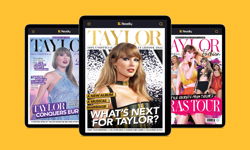The line separating the digital and physical world is being blurred more and more every day. In the not-too-distant future, new devices will far-outpace today’s webcams and mobile phones to seamlessly meld the virtual world of Internet with finite, everyday things. Magazines will be no exception to this trend.
Hints of that future are popping up today.
Imagine holding up your mobile phone’s camera. On the screen is the image of the street in front of you, but it is enhanced with information about what you are looking at - reviews of the best pubs in the area, where to find the nearest public transportation stop, or even a virtual tour of a museum. This is the idea behind Layar.
Introduced in the Netherlands in June 2009, Layar bills itself as the world’s first mobile augmented reality browser. It works by taking the view through the phone and adding content, including audio and video, known as layers on top of the view on the phone’s screen.
Layar is quickly adding to its repertoire by teaming up with numerous directories, companies, schools, museums, transportation agencies and others to provide content in the U.S., the rest of Europe, and Japan. With hundreds of layers already available, and more being added each day, this technology is set to take off.
To create a layer, a company teams up with a developer who customizes it to the company’s needs. Jeroen Meijer from Muzar.org is one such developer. He is currently in talks with magazine publishers about how to expand this technology to aid magazines.
“If one sees magazines as a way of communication, and sees a publisher as a distributor, Layar is a new form of distribution,” explained Meijer, “It adds to the possibilities of magazines.”
Dagbladet, one of Norway’s largest newspapers, has already created a layer that provides reviews of restaurants taken from its website.
However, the power of Layar remains largely untapped by the magazine industry.
Now imagine not even having to bother to take out your cell phone and fiddle with its buttons and touch screens, but still having constant access to the digital data about the world surrounding you. Wearable user interfaces may soon make such dreams a reality.
Take for example SixthSense, designed by Pranav Mistry, a Ph.D. student at the Massachusetts Institute for Technology’s Media Lab.
Mistry looks through the eyes of a clairvoyant, imaging a world in which everyone wears their own personal computer. SixthSense uses hand gestures to call forth information from the digital world as needed, including video, audio, or other additional or updated content that just can’t be put in print.
Talking at a TEDIndia conference in November 2009, Mistry explained, “You can carry the digital world with you wherever you go.”
Use an index finger to “draw” a circle on your wrist and SixthSense projects an image of a watch face, a virtual timepiece. It also has the power to replace e-readers and tablets, allowing digital versions of magazines to be projected onto any available surface, a wall, a piece of paper.
For example, using SixthSense will enable a magazine to show daily events information, theatre listings on the go in any street, or a video of an event projected on the print version itself. No more looking it up on your computer.
However, those diving into the future must remember the present, at least for a while.
“If you want to start a relationship with new technology, offer on it what you cannot offer in print — complement your product,” cautioned Samir Husni, director of the Magazine Innovation Center at the University of Mississippi. Indeed, even in an ever-changing digital world, the success of magazines will be not digital deliverance via new technological platforms but providing the content and storytelling for these platforms. It is the wine and not the bottle.
WHAT IS LAYAR?
Layar transforms the real world, through a mobile phone, into an interactive digital world, also known as augmented reality. For example, in Ireland, Pubs Galore finds community written reviews of bars on the street and nearby. The Layar app lets the user switch between “reality”, interactive street maps, and other information. As the view and location changes, so does the information.
HOW DOES SIXTHSENSE WORK?
SixthSense is simply a mobile phone, a camera, projector and software that allows the wearer to project and interact with digital information in the real world. Stereotyped hand gestures activate and control its many functions. For example, making a “window” with the thumbs and index fingers, à la Madonna Vogue, asks the camera to take a picture of the scene.










